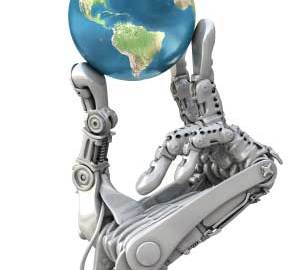Technology will Exceed Humanities Growth

In today’s excerpt – the accelerating pace of change. I began my career in financial services in the late 1970s. In my first decade in that industry, there were only a handful of new products introduced, and the number of new computer products offered to support our industry by then-dominant IBM was equally small. Today, there are new financial products introduced every day and an uninterruptible explosion of new technology offerings. In fact, when graphed, the pace of change in an increasing number of industries is moving forward at an exponential rate – doubling every one to two years.
In the view of esteemed inventor Ray Kurzweil, the pace of technological change in our world is now accelerating so rapidly that there will soon be no distinction between human and machine or between physical and virtual reality – and eventually our technology will match and then vastly exceed the refinement and suppleness of what we regard as the best of human traits:
“Consider this parable: a lake owner wants to stay at home to tend to the lake’s fish and make certain that the lake itself will not become covered with lily pads, which are said to double their number every few days. Month after month, he patiently waits, yet only tiny patches of lily pads can be discerned, and they don’t seem to be expanding in any noticeable way. With the lily pads covering less than one percent of the lake, the owner figures that it’s safe to take a vacation and leaves with his family. When he returns a few weeks later, he’s shocked to discover that the entire lake has become covered with the pads, and his fish have perished. By doubling their number every few days, the last seven doublings were sufficient to extend the pads’ coverage to the entire lake. (Seven doublings extended their reach 128-fold.) This is the nature of exponential growth.
“Consider Gary Kasparov, who scorned the pathetic state of computer chess in 1992. Yet the relentless doubling of computer power every year enabled a computer to defeat him only five years later. The list of ways computers can now exceed human capabilities is rapidly growing. Moreover, the once narrow applications of computer intelligence are gradually broadening in one type of activity after another. For example, computers are diagnosing electrocardiograms and medical images, flying and landing airplanes, controlling the tactical decisions of automated weapons, making credit and financial decisions, and being given responsibility for many other tasks that used to require human intelligence. The performance of these systems is increasingly based on integrating multiple types of artificial intelligence (AI). But as long as there is an AI shortcoming in any such area of endeavor, skeptics will point to that area as an inherent bastion of permanent human superiority over the capabilities of our own creations. …
“Although impressive in many respects, the human brain suffers from severe limitations. We use its massive parallelism (one hundred trillion interneuronal connections operating simultaneously) to quickly recognize subtle patterns. But our thinking is extremely slow: the basic neural transactions are several million times slower than con-temporary electronic circuits. That makes our physiological bandwidth for processing new information extremely limited compared to the exponential growth of the overall human knowledge base. …
“While human intelligence is sometimes capable of soaring in its creativity and expressiveness, much human thought is derivative, petty, and circumscribed. The [acceleration of technological change] will allow us to transcend these limitations of our biological bodies and brains. We will gain power over our fates. Our mortality will be in our own hands. We will be able to live as long as we want (a subtly different statement from saying we will live forever). We will fully understand human thinking and will vastly extend and expand its reach. By the end of this century, the non-biological portion of our intelligence will be trillions of trillions of times more powerful than unaided human intelligence. …
“Before the middle of this century, the growth rates of our technology – which will be indistinguishable from ourselves – will be so steep as to appear essentially vertical. From a strictly mathematical perspective, the growth rates will still be finite but so extreme that the changes they bring about will appear to rupture the fabric of human history. That, at least, will be the perspective of unenhanced biological humanity.
“[The result will ultimately] be no distinction between human and machine or between physical and virtual reality. If you wonder what will remain unequivocally human in such a world, it’s simply this quality: ours is the species that inherently seeks to extend its physical and mental reach beyond current limitations.
“Many commentators on these changes focus on what they perceive as a loss of some vital aspect of our humanity that will result from this transition. This perspective stems, however, from a misunderstanding of what our technology will become. All the machines we have met to date lack the essential subtlety of human biological qualities. Although [long-term technological change] has many faces, its most important implication is this: our technology will match and then vastly exceed the refinement and suppleness of what we regard as the best of human traits.”
author:
Ray Kurzweil
title:
The Singularity is Near
publisher:
Penguin
date:
Copyright 2005 by Ray Kurzweil
pages:
8-9





